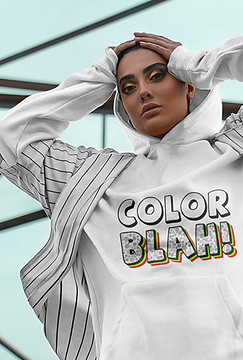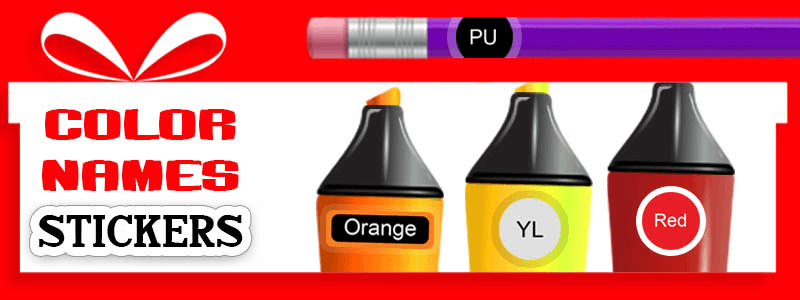TIPS & TRICKS FOR DAILY LIFE
Tips & Tricks to Handle Any Color-related Situation You Might Face
This course is your chance to "refine" your life and get all of the best strategies for taking control of your color choices, becoming a pro at color matching, breaking down the limits and stigma, and enjoying your new SELF!
Click here to start this FREE online course from the beginning.
3. OTHER COLORS
ON THIS PAGE:
**See this page till the end**
-
SECONDARY COLORS
The secondary colors, Orange, Violet, and Green are made by mixing two primary colors.
WATCH THIS VIDEO
SECONDARY COLORS
-
Green = Yellow + Blue
-
Orange = Yellow + Red
-
purple or Violet = Red + Blue

GREEN
Green is a lively color, and it symbolizes renewal and growth. It is the color you see the most in the natural environment. It is the color of spring when everything blooms. And it depicts the period when everything is alive and unrolling its natural processes.
Green also means balance, calm, and harmony. So it is a great color to have around when you are trying to restart yourself after a hard day. It is the reason we feel so great when we are out in the open space.
.jpg)
Let’s have a look at some of the GREEN logos to understand this color better.

ORANGE
Orange is a combination of red and yellow. Red is filled with energy and stimulation, and yellow is responsible for happiness and cheerfulness. It is a more active color because it makes us react based on gut feelings.
It is the color that gives you shelter in tough moments, by not allowing you to sink into grief or disappointment. It brings a high degree of positivism.
.jpg)
Let’s have a look at some of the ORANGE logos to understand this color better.

PURPLE – VIOLET - MAGENTA:
Colorblind people can’t see purple, violet, and magenta colors perfectly, and we usually see them as blue.
Commonly, people think about pigment, and in that case, the color you get when mixing blue and red would be purple.
Purple is associated with luxury, power, wisdom, creativity, and magic. When you look at purple in a psychological manner, it is the color that balances red and blue.
Red tends to bring intensity and energy to the color, while blue brings relaxation and stability; together, they make a brilliant color that balances red and blue. Red tends to bring intensity and energy to the color, while blue brings relaxation and stability; together, they make the brilliant color purple, which is the perfect balance of the two.
Light purple has feminine energy, while bright purple is linked with richness and royalty. Dark purple can be associated with sadness and frustration.
.jpg)
However, if you are referring to additive color (light), then the result of mixing red and blue light would be magenta.
In paint, mixing primary red and primary blue in equal amounts will give you a deep purple. It might even be very dark in comparison to what you are used to calling purple.
It’s amazing to know that Purple objects are “red and blue at the same time.
The difference between purple and violet is that violet is on the blue side of purple and is a deeper color than purple.
Purple is more reddish and saturated, while violet is more bluish and less saturated.

In the color wheel historically used by painters, Violet is located between blue and purple.
If we combine blue with violet we will have indigo.
But on the other hand, Magenta is a color in between red and purple, or pink and purple. Sometimes it is confused with pink or purple. It's defined as purplish-red, reddish-purple, or mauve-crimson.
Let’s have a look at some of these color logos to understand them better.

-
TERTIARY COLORS
The combination of primary and secondary colors is known as tertiary or intermediate colors, due to their compound nature.
WATCH THIS VIDEO
.jpg)
This illustrative organization of color hues around a circle, which shows the relationships between primary colors, secondary colors, and tertiary colors is called a color wheel or color circle.
-
OTHER COLORS
BLACK, WHITE, GRAY, PINK, BROWN, BEIGE, CREAM, TURQUOISE
WATCH THIS VIDEO
BLACK, WHITE, GRAY
The black color is the absence of color. The color black represents strength, seriousness, power, and authority. Black is a formal, elegant, and prestigious color.
The black color can be serious, professional, and conventional, but black can also represent the mysterious, sexy, and sophisticated.
It likes to stay hidden, in control, and separate from others. For this reason, black is a great color for high contrast and easy legibility.
White is the lightest color and is achromatic and is the opposite of black.
White is a color that is complete and pure, making it a perfect example of purity, innocence, cleanliness, and peace.
The color white affects the mind and body by aiding in mental clarity and promoting feelings of fresh beginnings and renewal.
Gray is a cool, neutral, and balanced color. The color gray is an emotionless, moody color that is typically associated with meanings dull, dirty, and dingy, as well as formal, conservative, and sophisticated.
The color gray is a timeless and practical color that is often associated with loss or depression. Dark, charcoal gray communicates some of the strength and mystery of black. It is a sophisticated color that lacks the negativity of the color black. Light grays can carry some of the attributes of the color white.
PINK
Pink, a delicate color that means sweet, nice, playful, cute, romantic, charming, feminine, and tenderness, is associated with bubble gum, flowers, babies, little girls, cotton candy, and sweetness.
Pink is a softer, less intense version of red that creates a sense of compassion and unconditional love.
Pink will sit well with colors close to it on the color wheel, like reds, and purples. This would be an analogous scheme.
For a complimentary theme, you could use green with pink.
In contrast yellow, blue, and orange can work.
It will work with black, white, gray, silver, and gold too.
BROWN
Brown is a composite color that can be produced by combining red, yellow, and black pigments, or by a combination of orange and black
Brown, the color of earth, wood, stone, wholesomeness, reliability, elegance, security, healing, home, grounding, foundations, stability, warmth, and honesty, is a natural, neutral color.
Neutral colors include black, white, gray, and sometimes brown and beige. They are sometimes called “earth tones.”
Brown is not on the color wheel.
Brown looks good with many colors, we saw it a lot with green in nature. It looks good with neutral colors. Depending on the color scheme we can use it with blue, yellow or with red.
BEIGE
Beige is variously described as a pale sandy fawn color, a grayish tan, a light-grayish yellowish-brown, or a pale to grayish-yellow.
The color beige is neutral, calm, and relaxing and its one of the most popular colors in interior design.
The color beige offers some of the warmth of the color brown and some of the crisp and coolness of the color white.
A warm beige would be complemented by green. A yellow-beige would be complemented by violet, and a blue beige would be complemented by orange.
CREAM
Cream, a simple yellowish-white, seems neutral enough to pair with almost any color, In art, the cream is often used as a base for skin tones.
TURQUOISE
Turquoise, a blend of the color blue and the color green, has some of the same cool and calming attributes.

WARM & COOL COLORS
Warm and cool colors are categorized as warm and cool due to the feelings that one gets when looking at the hues.
Warm colors — such as red, yellow, and orange; evoke warmth because they remind us of things like the sun or fire.
Warm colors will feel inviting and comforting, and provide the illusion of heat and warmth. Since these colors advance toward the eye, they work well in large spaces in order to make them feel cozy and secure. Warm colors can also be stimulating. They often evoke strong emotions and promote activity, so these colors are ideal for gyms and living rooms.
Advertisers often use warm colors to provide a sense of urgency.
%20(2).jpg)
Cool colors — such as blue, green, and purple (violet); evoke a cool feeling because they remind us of things like water or grass.
Cool colors have nearly the opposite effects of warm colors. Receding from the eye, cool colors can make space feel larger and more open. These hues work well in smaller rooms in order to increase the perceived size of the area. Additionally, cool colors provide a sense of calm and relaxation. They are ideal for small spaces that are intended to be tranquil, such as bathrooms and bedrooms. Cool colors also influence people by evoking a sense of health, tranquility, and wisdom.
.jpg)
COLOR PSYCHOLOGY: Does It Affect How You Feel?
Color can play an important role in conveying information, creating certain moods, and even influencing the decisions people make. Color preferences also exert an influence on the objects people choose to purchase, the clothes they wear, and the way they adorn their environments.
It's useful to bear in mind our most prevalent color associations when you begin your color journey and assess what hues best suit your logo, website, or other branding endeavors.
People frequently choose products whose hues arouse particular emotions or moods, such as choosing a car's color to appear sporty, modern, svelte, or reliable. In order to produce a certain mood, room colors can also be used, such as painting a bedroom a gentle green.
Click here to DOWNLOAD this image




